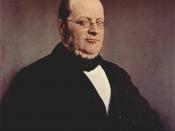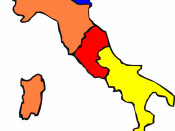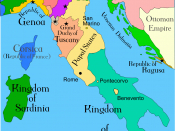Unification of Italy
Q: Describe & Explain the Unification of Italy.
The Unification of Italy divides in to 3 main stages: 1815-1830: Revolts all over Italy. Revolts are suppressed. 1848-1849: Revolts all over Italy. Revolts are suppressed. 1858-1870: The unification of Italy
Introduction To understand the unification of Italy, matters before the revolution need to be examined.
Up until 1716, Italy was just a big piece of land divided among small kingdoms of monarchs. (ref. H.O. #1 p.29)
When napoleon Bonaparte conquered Italy, he left them 3 things, which were probably the key characteristics in the revolution: - Efficient Government. - A practical demonstrations of the benefits from a unified Italy - Hatred towards foreign influence.
After the fall of Napoleon, the major European powers (Austria, Russia, Spain, United Kingdom, & Prussia) what was to be done with Italy, which was conquered at the time by Napoleon.
It was thus decided that Italy would be divided among different monarchs, all associated with the Habsburgs (except for Piedmont Sardinia, which was to be ruled by Victor Emmanuel, an independent monarch, and Papal States, ruled by the pope.). (ref. H.O. #1 p. 29-30)
Austria had very strong domination over Italy. It had agreements with Ferdinand, king of Kingdom of the 2 Sicilies, and helped the pope maintain his kingdom. Only Piedmont Sardinia wasn't influenced by Austria (ref. H.O. #1 p. 30).
1815 - 1830 Revolution Almost all "'Italians" hated the foreign influence of Austria on Italy.
Metternich, an Austrian prince wanted to make sure no nationalist activities were in process in Austria's territories in Italy (which was Lombardy Venetia).
He imposed repressive rule in Lombardy Venetia. German was the official language, a strong Austrian army was always present to suppress any hostile activities, an efficient system of spies...


